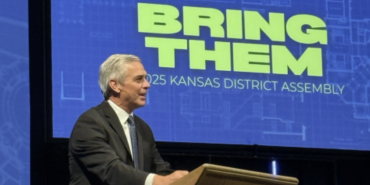The Closer: Phineas Bresee and Church Union

In baseball, a ball pitcher assumes one of three roles: starter, reliever, or closer. The closer's job is to protect the team's gains and close out the game on a triumphant note.
C. W. Ruth's wide-ranging travels brought him into personal contact with other holiness groups. He was the starter in each of four steps that created the Pentecostal Church of the Nazarene between October 1907 and October 1908.1
Bresee was the reliever if needed, but always the closer. Following behind Ruth, he met leaders of other groups, including some very independent-minded people. He "closed out the game" in face-to-face meetings where he persuaded others to unite around his convictions of how best to structure a united holiness church.
He achieved results through a combination of personal traits.
First, he attracted other strong leaders to himself and his cause, winning their respect and allegiance through personal piety, common sense, breadth of mind, and depth of experience.
Second, he wore the mantle of "general superintendent" gracefully, modeling the episcopal role within a democratic system and reassuring those, especially in the Eastern U.S., who were initially suspicious of the office.
Third, he was an exemplary pastor. He was founding pastor of the united church's largest congregation, Los Angeles First Church, with nearly 1,000 members. It had grown steadily through his pastoral skill and he was a model for other pastors to emulate.
His leadership to the general church was the simple outworking on a broader stage of his pastoral character and ministry.
Fourth, he was "a preacher's preacher." This was crystal clear at Pilot Point, as the Pentecostal Church of the Nazarene and the Holiness Church of Christ inched toward merger. The joint assembly opened on the afternoon of October 8, 1908. Bresee took the pulpit shortly thereafter and preached a memorable sermon from Isaiah 60.
Later, J. B. Chapman reflected on its meaning for those gathered: "His patriarchal appearance so impressed that I think I was more or less prepared for the marvelous address he gave...It was the presence and bearing and emphasis of the man that made the impression and constituted this an occasion of a lifetime - yea, even of a century. I suspect it was the climax of Bresee's life and ministry, and I suspect it was the climax in life for many of us who were there."
The sermon was followed by the Lord's Supper in which "the fire that had been kindled during the opening address burst into a halo of glory... Here were delegates from California and New York, from Texas, and from Canada, with spirits so perfectly blended into one that any sinner would immediately recognize that they were brothers, and have in common some unifying agency. Here was a re-enacted Pentecost, with all filled with the Holy Ghost."2
A spirit of unity generated through sermon and sacrament led to harmony and compromise in the committee work that followed.
Committed to uniting the regional churches, Bresee secured concessions from the Southerners and from his own group, and on October 13, at 10:40 in the morning, the vote to merge the denominations was taken, followed by scenes of great joy and a "Hallelujah March" around the meeting tent.1
The four steps were:
(1) union between the Church of the Nazarene and the Association of Pentecostal Churches of America at Chicago in October 1907,
(2) major accessions from the Holiness Association of Texas in spring 1908,
(3) the merger of the Pennsylvania Conference of the Holiness Christian Church in September 1908, and
(4) the merger with the Holiness Church of Christ in October at Pilot Point, Texas.2
J. B. Chapman, "Dr. Bresee an Apostolic Leader," Preacher's Magazine (Dec. 1938): 2-3, 14, quotes from p. 2.
Stan Ingersol is manager of the Nazarene Archives for the Church of the Nazarene.
Holiness Today, July/August 2008
Please note: This article was originally published in 2008. All facts, figures, and titles were accurate to the best of our knowledge at that time but may have since changed.




